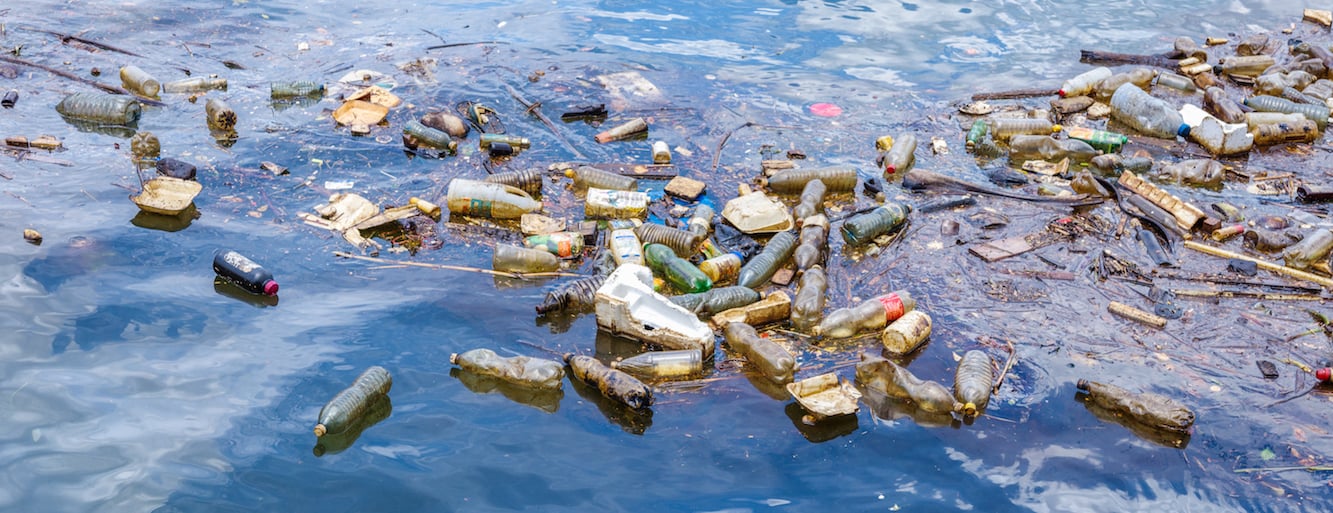A Guide to Ocean and Marine Pollution
Earth and all who live on it depend heavily on the oceans. The world’s oceans cover as much as 70 percent of the planet and are responsible for producing more than 50 percent of its oxygen. Oceans help to regulate weather patterns and climate, serve as a source of food, and offer resources used in the production of important medicines, including some used to combat serious problems such as heart disease and cancer. The oceans also support a vast array of creatures, from microscopic algae to aquatic plants and wildlife. A majority of life on Earth lives within them, and the world outside of them could not exist without them.
Despite their importance, however, humanity has not been gentle or kind to the oceans. The side effects of modern living have had a devastating effect on oceans and their inhabitants. Plastics, carbon emissions, and oil leaks and spills are some of the ways that people have polluted the oceans. The best way to start helping to reverse this damage is to understand the different types of pollution and how they are harmful.
Ocean Acidification
Most people are aware that burning fossil fuels contributes to the problem of climate change by releasing excessive carbon dioxide into the atmosphere. The atmosphere, however, is not the only thing adversely affected by this. A quarter of man-made carbon dioxide from fossil fuel is absorbed by the oceans, as much as 22 million tons of it a day. This reduces the surface water’s pH as its acidity increases. Currently, the oceans are acidifying faster than they have in the past 300 million years, and they could be as much as 150 percent more acidic if changes do not happen by the end of the century.
Acidification causes a decrease in carbonate levels, needed for the compound calcium carbonate. Calcium carbonate is necessary for building the shells of mussels, shrimp, oysters, and clams. Changes in the water’s pH can impact fish’s brains and how they react. It can make it more difficult for both predators and prey to sense one another’s presence in the water, and it may be causing reproductive disorders in some fish. Additionally, ocean acidification also contributes to the bleaching of coral reef.
- What Is Ocean Acidification?
- Ocean Acidification
- Coral Reef Stressors: Ocean Acidification
- How Growing Sea Plants Can Help Slow Ocean Acidification
- Can Seagrass Help Fight Ocean Acidification?
Trash in the Ocean
The ocean is an unfortunate receptacle for a significant amount of land-based trash. As much as 80 percent of oceanic litter comes from sources on land through routes such as storm drains and sewers. Much of this litter is made of plastic, which is particularly harmful to the environment and ocean life because it can remain in the environment without degrading for millions of years. Additionally, certain plastic items can strangle, suffocate and otherwise harm fish, seabirds, and other marine animals that may ingest or become tangled in them. While plastic is a top concern, it isn’t the only source of worry. Liquid waste such as oil from vehicles, chemicals from factories, agricultural runoff, and raw sewage overflow can also end up in the ocean.
- Ocean Trash Plaguing Our Sea
- We Made Plastic: Now, We’re Drowning In It
- Plastics in the Ocean Affecting Human Health
- Sea Sick: Plastic Garbage in the North Atlantic Ocean Skyrocketing
- Marine Debris Hurts Human Health, Marine Life, and South Florida’s Economy
Ocean Noise
While the ocean may not seem like a noisy place to human ears, there is a significant amount of noise below the surface, and much of it is human-generated noise pollution. Sound is often a problem in salt water, as it travels faster and spreads farther than noise in the air and is disruptive to underwater life. Tankers and other ships on the water and sonar used by the Navy are major causes of noise pollution. Sonar has been known to cause whales to beach themselves, and the noise caused by boating causes whales and fish to become disoriented and may drown out sounds that they rely on. Another culprit is high-powered air guns used in offshore exploration by the oil and gas industry, which are used for weeks or months at a time. The blasts from these guns occur approximately every 12 seconds and cause underwater seismic blasts that are highly disruptive to underwater life. This causes some fish to leave their habitats and disrupts the behavior and mating habits of other species, including whales. Marine life such as crabs, squid, and scallops may even die as a result of these blasts.
- Oceans Are Getting Louder, Posing Potential Threats to Marine Life
- Effects of Noise on Marine Animals
- Marine Life Needs Protection From Noise Pollution
- Underwater Noise Consequences
- The Impact of Noise Pollution on Marine Biodiversity (PDF)
Offshore Drilling
Offshore drilling by oil and gas companies causes a number of additional problems. Not only are these operations a source of noise pollution, but they are also the cause of oil spills, of which there are thousands annually in the U.S. When oil spills, the damage is devastating to the water and to marine life. The impact of a spill can last for decades. Even cleanups only remove a small amount of the oil, and the techniques used often involve more hazardous chemicals. Chemicals from drilling may damage the organs of animals, such as marine mammals, that come into contact with them. The response to offshore drilling mishaps also has a long-term disruptive impact on ocean animals.
- Impacts of Offshore Drilling
- What Effects Does Oil Drilling Have on the Ocean?
- Fact Sheet on Offshore Oil Drilling (PDF)
- Drilling Is Tragic for Marine Life (PDF)
- Future Offshore Drilling Could Wreak Havoc on Deep Sea Ecosystems
How to Help
People shouldn’t give up hope or put up their yachts for sale just yet. The ocean isn’t a lost cause. Everyone can take daily steps to help reduce the amount of pollution in the ocean. They can start by being conscious of bad habits and choices. Families and individuals alike can begin making thoughtful and effective changes to their regular routines. While one person alone cannot overcome water pollution, they can encourage discussion and teach others the benefits of doing their part.
Reducing Water
One can reduce water pollution by reducing the amount of polluted water that leaves their property through runoff. One way to do this is to prevent water from flowing down hard surfaces such as driveways and into storm drains by using gravel or other porous materials. Picking up after pets prevents their waste from being washed into the water supply by sprinklers or rainfall. Another way to reduce water pollution is to avoid putting hazardous substances like chemicals or medications down the drain or in the toilet. Things that are not biodegradable, such as sanitary napkins, should also not be flushed. Appropriate car care also helps reduce water pollution, as it decreases the risk of oil, coolant, or other chemicals flowing into drains and eventually contaminating the ocean. Even washing cars at car washes versus one’s driveway can help control polluted water.
Plastic Consumption
Decreasing one’s plastic consumption is crucial to reduce the amount that ends up in oceans. One way to use less is to avoid single-use plastics when possible. Use reusable items in place of disposable ones, such as reusable straws, coffee cups, and grocery bags. If it is necessary to dispose of plastic, give it a new life by taking it to be recycled instead. Plastic is often found in unexpected places, such as facial cleansers and body washes, so read labels carefully. Some of these products contain microbeads, which are very tiny plastic particles that can threaten the health of marine life. Ingredients on the packaging of microbead products will typically include the ingredients polypropylene and polyethylene.
Become an Advocate
Taking action and speaking out about threats to our oceans is critical to helping them. Every day, wealthy politicians and corporations are doing more than just relaxing on their chartered yachts; they’re making decisions that impact the oceans for better or worse. By joining organizations and advocacy groups that are making strides to keep the oceans and their inhabitants safe, people can take an active role in helping the oceans of the world. Other ways to get involved while being seen and heard include joining marches and protests. Also, speak out to friends and family about what’s happening to the oceans and the impact it will have on the future.
- 11 Amazing Organizations Fighting to Save Our Oceans (slide show)
Organize Cleanups
While enjoying their new or used yachts, the last thing people want to see is a lot of trash. Take action by organizing a cleanup of a beach or river. During the cleanup, participants can remove the plastic trash and other wastes that would eventually be swept into the water and out to sea. A cleanup can easily be organized by involving friends, neighbors, or coworkers.

